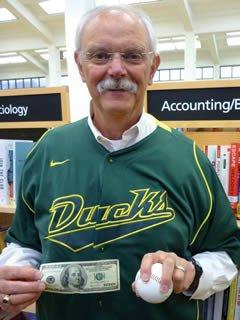Teaching the takeaways from "Moneyball"

Jim Terborg ’70 isn’t all that enamored with baseball. But he got excited when he read Moneyball, the story of how the Oakland Athletics went from pathetic to a Major League Baseball powerhouse.
“I thought, wow, this book is packed with examples of the psychology of innovation and change,” he said.
Terborg, chair of the management department in the Lundquist College of Business at the University of Oregon, began telling his students the Moneyball story years before it became a movie starring Brad Pitt.
“Billy Beane, the A’s general manager, had such a restricted budget that he had to find a different way to identify talent,” Terborg explained.“First, he changed the game’s objective from scoring runs to not making outs. Then, using a scientific analysis of the reams of statistics available on every player, he discovered that the indicators of a player’s productivity for the team weren’t the indicators that managers had always looked for. For example, the player who never swings at the first pitch and gets on base a lot, even by walking, is more valuable than the player who hits home runs but doesn’t get on base as often.
“Moneyball reinforced my belief that the quality of people you hire and how you motivate and manage them makes a big difference in any business,” he continued. “Too often greater emphasis is placed on non-worker elements, such as finance or new technology.”
Terborg pooled his Moneyball insights with those of several colleagues and in 2005 presented them in a symposium at the Academy of Management. That symposium later became a paper in the International Journal of Sport Finance.
Another important takeaway from the Moneyball story, Terborg said, is that “copying all the items of a change without copying its essence won’t work. It’s not as if another team could simply apply Beane’s statistical analysis and be successful. Everything else—support from top management, team infrastructure, the reward system— has to be aligned with the change.”
He extends the example to businesses outside sports:
“Southwest Airlines has been the most profitable airline in the U.S. over the last 30 years. But when other airlines tried to copy elements of Southwest’s practice—no meals, no boarding passes and so on—they failed. It wasn’t a change of essence.”
Applying the lessons of Moneyball to other businesses wasn’t the first time Terborg found sports to be a fertile field for researching management questions. As early as 2001 he was urging colleagues to use professional sports to study organizational behavior in general.
“Think of all the statistics compiled in pro sports,” he pointed out. “If you want to understand a particular impact, the data is right there. For example, my current research looks at offensive and defensive lines in pro football to understand work group productivity.”
His study of business through the lens of sports led to Terborg’s appointment in 2006 as the academic director of the Warsaw Center for Sports Marketing at the Lundquist College of Business. In that position he’s taken students to China for World Cup soccer, to Alaska’s Iditarod dog sled race and to meetings with the commissioners of the National Basketball Association, the National Football League and the National Hockey League.
Whether writing about the lessons for business from Moneyball or consulting with Nike about promoting health programs in the workplace, Terborg said a common theme runs through his work: “All of it reflects a desire to make the workplace a better place.”






